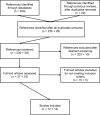Alliance matters: but how much? A systematic review on therapeutic alliance and outcome in patients with anorexia nervosa and bulimia nervosa
- PMID: 34374966
- PMCID: PMC9079014
- DOI: 10.1007/s40519-021-01281-7
Alliance matters: but how much? A systematic review on therapeutic alliance and outcome in patients with anorexia nervosa and bulimia nervosa
Abstract
Purpose: Patients with eating disorders (ED) pose a high-risk group regarding relapse. The understanding of factors contributing to a better outcome is much-needed. Therapeutic alliance (TA) is one important, pantheoretical variable in the treatment process, which has shown to be connected with outcome. This review looks into a possible predictive effect of TA on outcome as well as related variables.
Methods: A systematic review with pre-determined inclusion criteria following the PRISMA guidelines was conducted for studies published since 2014. Three previous reviews including studies up until 2014 were analyzed for studies matching our inclusion criteria. A total of 26 studies were included.
Results: The results were heterogeneous between different patient groups. Regarding the predictive effect of TA, in adolescent samples, the TA of either the patients or their parents seems to impact outcome as well as completion. For adults, results are mixed, with a tendency to a greater impact of TA for anorexia nervosa (AN) patients, while some samples of adult bulimia nervosa (BN) patients did not find any relation between TA and outcome.
Conclusion: The effect of TA on clinical outcome depends on the patient group. TA has a greater impact on adolescents, irrespective of diagnosis, and on adults with AN. The examined studies have different limitations which include small sample sizes and questionable study design. The examination of motivation as a potential influencing factor is recommended.
Level of evidence: Level I, systematic review.
Keywords: Anorexia nervosa; Bulimia nervosa; Eating disorders; Outcome; Systematic review; Therapeutic alliance; Working alliance.
© 2021. The Author(s).
Conflict of interest statement
The authors have no conflicts of interest to declare that are relevant to the content of this article.
Similar articles
-
Psychotherapy for bulimia nervosa and binging.Cochrane Database Syst Rev. 2003;(1):CD000562. doi: 10.1002/14651858.CD000562. Cochrane Database Syst Rev. 2003. Update in: Cochrane Database Syst Rev. 2004;(3):CD000562. doi: 10.1002/14651858.CD000562.pub2. PMID: 12535397 Updated.
-
Psychotherapy for bulimia nervosa and binging.Cochrane Database Syst Rev. 2001;(3):CD000562. doi: 10.1002/14651858.CD000562. Cochrane Database Syst Rev. 2001. Update in: Cochrane Database Syst Rev. 2003;(1):CD000562. doi: 10.1002/14651858.CD000562. PMID: 11686968 Updated.
-
Psychotherapy for bulimia nervosa and binging.Cochrane Database Syst Rev. 2000;(4):CD000562. doi: 10.1002/14651858.CD000562. Cochrane Database Syst Rev. 2000. Update in: Cochrane Database Syst Rev. 2001;(3):CD000562. doi: 10.1002/14651858.CD000562. PMID: 11034689 Updated.
-
A systematic review comparing atypical anorexia nervosa and anorexia nervosa.Int J Eat Disord. 2023 Apr;56(4):798-820. doi: 10.1002/eat.23856. Epub 2022 Dec 12. Int J Eat Disord. 2023. PMID: 36508318
-
A systematic review and meta-analysis of the association between eating disorders and bone density.Osteoporos Int. 2016 Jun;27(6):1953-66. doi: 10.1007/s00198-015-3468-4. Epub 2016 Jan 18. Osteoporos Int. 2016. PMID: 26782684 Free PMC article.
Cited by
-
Premature termination of eating disorder treatment - a qualitative study of therapist perspectives.J Eat Disord. 2025 May 1;13(1):76. doi: 10.1186/s40337-025-01268-0. J Eat Disord. 2025. PMID: 40312385 Free PMC article.
-
A retrospective study of pharmacological treatment in anorexia nervosa: 6-month and 12-month follow-up.BMC Psychiatry. 2023 Feb 27;23(1):126. doi: 10.1186/s12888-023-04604-3. BMC Psychiatry. 2023. PMID: 36849970 Free PMC article. Review.
-
Discovering a "sense of community": patient experiences of connection in intentionally remote eating disorder care.J Eat Disord. 2024 Oct 30;12(1):171. doi: 10.1186/s40337-024-01127-4. J Eat Disord. 2024. PMID: 39478567 Free PMC article.
-
Discordant conceptualisations of eating disorder recovery and their influence on the construct of terminality.J Eat Disord. 2024 Jun 3;12(1):70. doi: 10.1186/s40337-024-01016-w. J Eat Disord. 2024. PMID: 38831456 Free PMC article.
-
A systematic review on the role of therapist characteristics in the treatment of eating disorders.Res Psychother. 2024 Jul 10;27(2):750. doi: 10.4081/ripppo.2024.750. Res Psychother. 2024. PMID: 38988291 Free PMC article.
References
Publication types
MeSH terms
LinkOut - more resources
Full Text Sources
Medical
Research Materials


